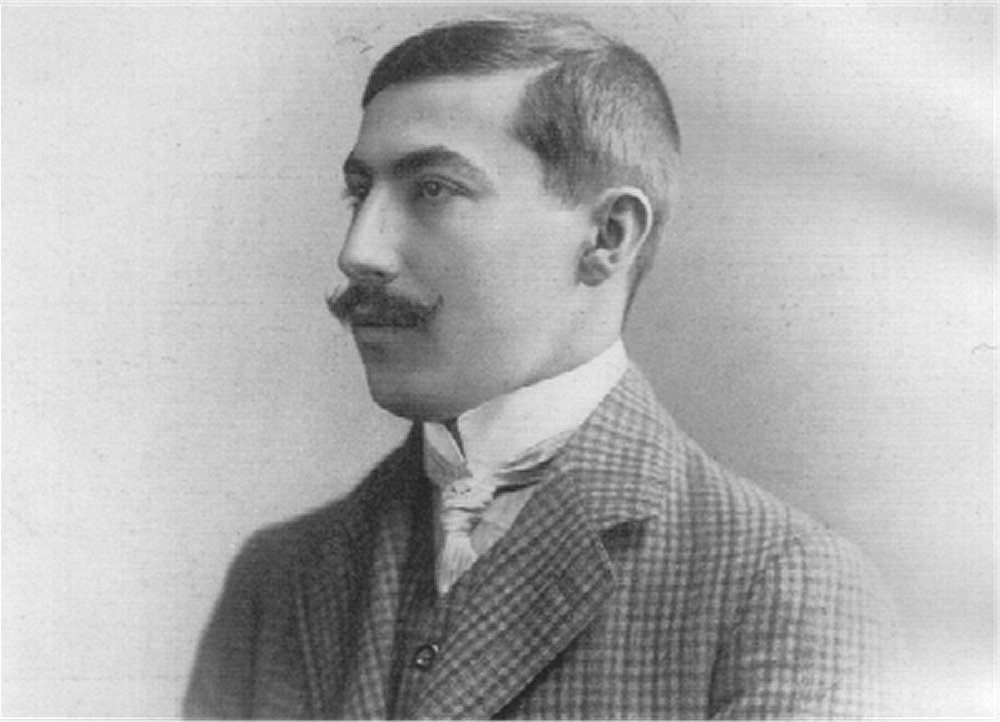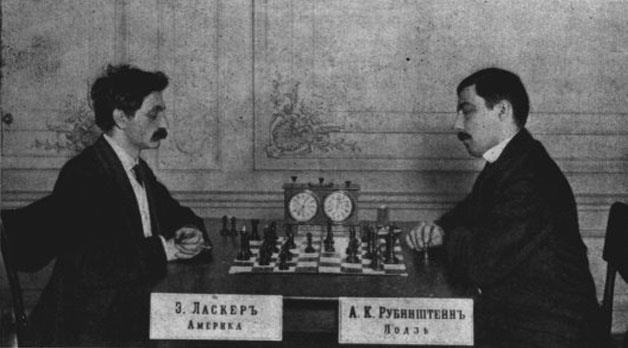


The chess of Akiba Rubinstein was clear and logical and has inspired generations of chess players. But Rubinstein's life was tragic. He was born in Stawiski, a small village in Poland, about 160 kilometers from Warsaw, but experts argue about the exact date of his birth. His gravestone gives December 1, 1880, other sources date Rubinstein's birth on October 12, or December 12, 1882.
Rubinstein's family was poor. He was the youngest of twelve children, his father died shortly before Rubinstein's birth and ten of Rubinstein's siblings died from tuberculosis at a young age. Rubinstein was supposed to follow the tradition of his family and become a rabbi and a scribe. But, as Ernst Strouhal writes:
[at 16 years of age] Rubinstein left the childhood misery of Stawiski and abandoned the study of Thora and Talmud to play chess. He now was one of the 'luftmenschn', as the jews without money or education were called, who moved from the shtetl to the slums of Warsaw, Lodz or Minsk. In the urban centres they formed a Jewish subproletariat, a class of parias among the parias.
(Ernst Strouhal, "Alles Schöne war geistig...", KARL, 03/2013, p. 12.)
Rubinstein later described his development as a chess player in an article for the Deutsche Zeitung Bohemia:
With chess I was already acquainted as a 14-year in the Cheder [the Jewish elementary school -Ed.]. When I was 16, I studied theory. Then I was told to go to Lodz where the great master Salwe lived. With him I perfected my chess, I was, so to speak, his apprentice. That's how became a master. I felt passion and talent vividly within me. I also have an extraordinarily good memory. For example, I still remember all the games I have played during my 21 years as a chess master. I do not have a good memory for names and locations, just a special chess memory. I am captivated by the aesthetic pleasure, which arises from a beautiful combination. I almost get into a feverish state. Chess is not only art, but also science. Fighting and victory take place on a scientific basis.
(Akiba Rubinstein, "Wie wurde ich Schachmeister?", Deutsche Zeitung Bohemia, 18. April 1926, p. 19, quoted in Strouhal, "Alles Schöne war geistig...", KARL, 03/2013, p. 17.)
In just a few years, Rubinstein's talent and hard work made him one of the best players in the world. In 1912 he won a number of major tournaments and in 1913 he achieved his best historical Elo rating of 2789. In retrospect, this makes him the world's best player at that time. However, all plans to play a world championship match against reigning world champion Dr. Emanuel Lasker came to nought, and were finally ruined by the outbreak of World War I, in 1914.

Akiba Rubinstein (right) against Emanuel Lasker, St. Petersburg 1909 | Photo: Tournament book
After the First World War, Rubinstein, despite a number of good results, no longer had his old playing strength. Moreover, mental and psychological problems from which he had suffered for a long time were now becoming more and more evident and led to a whole series of anecdotes about Rubinstein's strange behaviour at tournaments.
In 1917 Rubinstein married Eugenie Lew, who was eleven years younger than him. Jonas, the first son, was born in 1918, Samy, the second son, in 1927. In 1919, the Rubinstein family moved to Gothenburg and in 1926 to Belgium. In 1931 Rubinstein stopped playing tournament chess.
In 1942, his wife sent him to a mental hospital where he survived the Nazi persecution of the Jews. His wife and two sons could also save themselves from the Nazis. Rubinstein's wife Eugenie died in 1954, seven years before her husband, who died on March 15, 1961.
Rubinstein has made numerous contributions to opening theory and he is famous for the clarity and logic of his positional play and for his skill in rook endings, but his best-known game is a tactical masterpiece. It was played in Lodz, in 1907. Rubinstein had black, his opponent was Georg Rotlewi.
Rubinstein's games have influenced whole generations of chess players. Perhaps the best still active player among the many Rubinstein fans is Boris Gelfand, who has repeatedly emphasized how much he admires Rubinstein and how much his games influenced and inspired him. Gelfand's book Positional Decision Making in Chess, published in 2016, was a tribute to Rubinstein.

Boris Gelfand at the Aeroflot-Open 2016 | Photo: Amruta Mokal)
But it was Vishy Anand, who managed to "replay" the game Rotlewi vs Rubinstein against Levon Aronian at the Tata Steel Tournament in Wijk aan Zee 2013.

In the footsteps of Rubinstein: Vishy Anand | Photo: Amruta Mokal